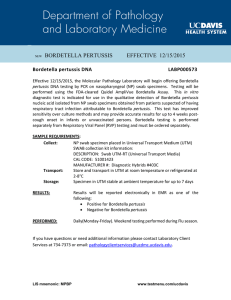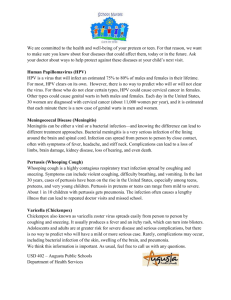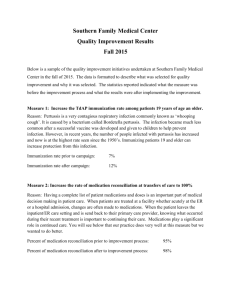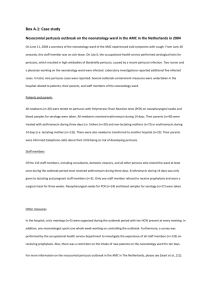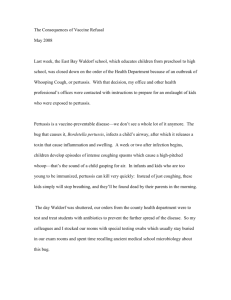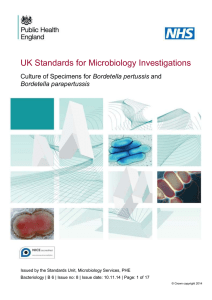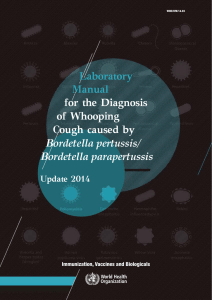Final Case Study - Cal State LA
advertisement
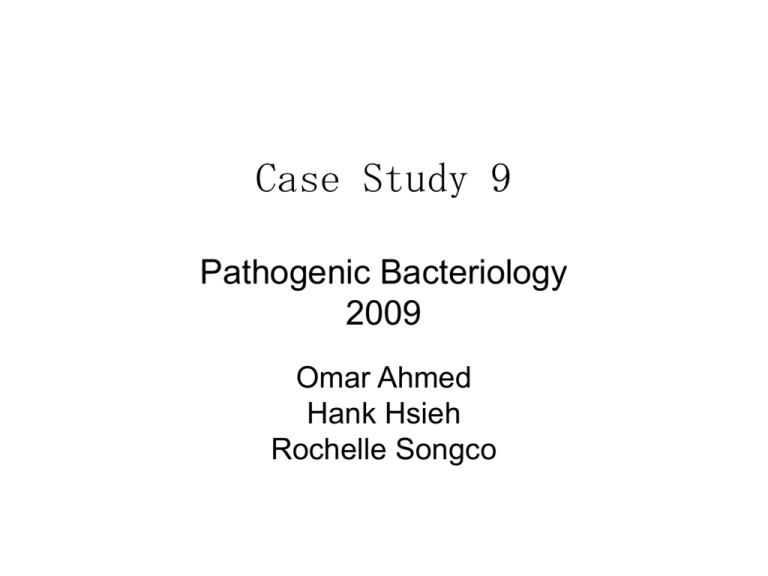
Case Study 9 Pathogenic Bacteriology 2009 Omar Ahmed Hank Hsieh Rochelle Songco Case Summary • 5 ½-week-old male • 10 day history of choking spells • Repetitive coughing, turning red, gasping for breath • Vomiting associated with choking spells in prior 2 days • Pulse – 160 bpm (elevated) • Respiratory rate – 72/min (elevated) • Chest radiograph is clear and trachea is normal • White cell count – 15,500/µL with 70% lymphocytes Key Information Pointing to Diagnosis • An elevated white cell count with 70% lymphocytes • Coughing spells, turning red, gasping for breath • Episodes of vomiting • Chest radiograph is clear indicating no pneumonia infection • No tracheal abnormalities These are all consistent with a pertussis infection The Diagnosis for Case 9 • Bordetella pertussis • Nasopharyngeal swab shown below source: faculty.matcmadison.edu/mljensen Classification,Gram Stain Results, and Microscopic Appearance of Bordetella pertussis • Genus: Bordetella • Gram-negative • Coccobacillus • Aerobic source: historique.net/microbes Diseases and Pathogenesis of Bordetella pertussis • Pertussis, which causes whooping cough • Infection of the respiratory tract • Children and young infants are most at risk • Most contagious before coughing begins Diagnosis/Isolation/Identification/ of Bordetella pertussis • Diagnosis based on… – repetitive coughing with choking, vomiting, and gasping for breath – Elevated pulse and respiratory rate – Elevated lymphocyte levels • Caused by a blocking of homing of lymphocytes to the spleen and lymph nodes – Culture from nasopharyngeal swab is most common method of detection due to the bacterial presence in nose and throat • Bordet-Gengou medium • Charcoal-horseblood agar • Detection of Bordetella DNA by PCR • Detection of IgA antibodies with ELISA Therapy, Prevention and Prognosis of Patient Infected with Bordetella pertussis • Erythromycin is the drug of choice against pertussis infection – Reduces duration by 5-10 days but not the course of the infection – Bacteria is slow growing so cough persists • DTaP vaccine available for children – Reported cases down 97% from pre-vaccine era • Tdap booster vaccine for adolescents and adults a A marked decrease in L-selectin expression by leucocytes in infants withBordetella pertussisinfection: leucocytosis explained? • Hodge, Greg, et al, 2003, A marked decrease in L-selectin expression by leucocytes in infants withBordetella pertussisinfection: leucocytosis explained?, Respirology, 8: 157-162. • Blood collected from 11 infants with B. pertussis infection prior to antibiotic therapy. Control group of 11 infants with non-pertussis related hospital admission. • Full blood counts conducted for WBCs and also test of cell origin (lymphoid, granulocytic, or monocytic). • Patients with B. pertussis infection showed a much higher absolute number of neutrophils, monocytes, and lymphocytes compared to control – L-selectin is removed from leucocytes by pathogen • Prevents migration of leucocytes and homing and invasion of T and B cells to peripheral lymphoid tissues • Leukocytosis is consistent with an infection of Bordetella pertussis = Take Home Message = Bordetella pertussis • Pertussis is a respiratory infection which causes “whooping cough” • Typical symptoms are initially cold-like followed by a stage of rapid coughing and finally a recovery stage of coughing which can last for weeks or months. • Pathogen which causes this infection is Bordetella pertussis • Diagnostics include a nasopharyngeal swab culture, DNA PCR, and ELISA test for antibodies • Erythromycin is the primary antibiotic used against an pertussis infection • Most children recover from the illness but pneumonia, apnea, encephalopathy, and rib fractures are complications associated with a pertussis infection • Immunization is effective against pertussis infections • Disease is spread by coughing and sneezing • Non-vaccinated infants and adolescents at most risk References • "Bordetella". National Center for Biotechnology Information. March, 09, 2009 <http://www.ncbi.nlm.nih.gov/books/bv.fcgi?rid=mme d.chapter.1684>. • "Vaccines VPD-VAC-Pertussis-main page". Centers for Disease Control and Prevention. March, 08, 2009 • "Pertussis Bacterial Infections Merck Manual Home Edition". MERCK. March, 07, 2009 <http://www.merck.com/mmhe/sec23/ch272/ch272g.html >. • McQueen, Nancy. Winter 2009. Bordetella, Francisella, and Brucella
